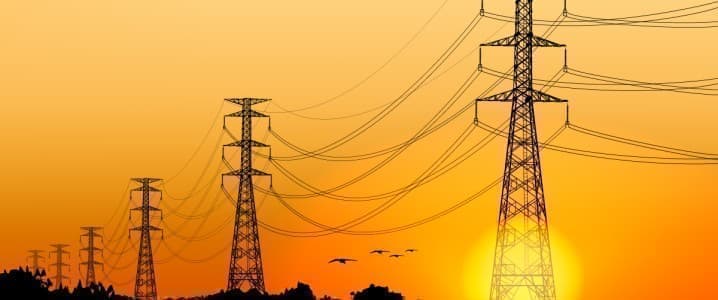After years of criticism around failures in U.S. energy infrastructure, progress is finally being seen with the approval of the development of several major new transmission lines across the country. As America’s green energy portfolio continues to grow, investment in energy infrastructure must reflect the enhanced renewable energy capacity, allowing for electricity to be distributed effectively and efficiently. Improvements in energy infrastructure could also decrease the risk of outages in the case of extreme weather events, as well as future-proof the grid for the anticipated rise in energy demand over the coming decades.
The development of new, high-voltage transmission lines is needed to connect new renewable energy projects to the grid. The new infrastructure will help transport green energy from wind and solar fields, as well as other renewable energy projects, to urban areas. Much of the existing infrastructure is not only unsuitable for the anticipated rise in electricity demand in the coming decades, but it also doesn’t reach many of the rural areas that are expected to be developed for green energy projects. A great deal of U.S. renewable energy capacity will be established in non-traditional energy regions, as they do not rely on natural resources to dictate where energy can be produced. Much of the new infrastructure will have to be linked with battery storage equipment to ensure the steady and reliable flow of electricity to populations across the country at all hours of the day and night.
This month, the Biden administration approved the construction of a 732-mile-long, high-voltage transmission line across the Western U.S. to help transport renewable energy. The line, known as the TransWest Express Project, will run from south-central Wyoming through northwestern Colorado and central Utah before arriving in southern Nevada, according to the Bureau of Land Management (BLM).
Before now, several projects have failed to get off the ground, despite the dire need for new energy infrastructure to support the growing demand for electricity across the U.S. Several multibillion-dollar transmission line proposals have faltered due to bureaucracy and a not-in-my-backyard public perception. But thanks to the approval of the $1 trillion bipartisan infrastructure law in 2021 and the introduction of the Inflation Reduction Act climate policy last year, things are finally progressing. And with the building of new infrastructure, the government hopes to overcome long-standing challenges, such as the outages experienced during extreme weather events.
The TransWest Express is part of the Biden administration’s aim to substantially enhance energy infrastructure across the country in line with the green transition. In 2020, the president announced the aim of a carbon-free electricity grid by 2035, which will require almost a complete overhaul of the existing infrastructure. The BLM Director, Tracy Stone-Manning, stated: “This large-scale transmission line will put people to work across our public lands and will help deliver clean, renewable energy.” In addition, “Our responsible use of public lands today can help ensure a clean energy future for us all,” said Stone-Manning.
The project is expected to create around 1,000 new jobs. It will carry electricity produced at the 3-gigawatt Chokecherry and Sierra Madre Wind Energy Project in Wyoming, North America’s largest onshore wind venture. It follows the BLM 2022 approval of the Energy Gateway South project, another high-voltage, multi-state transmission line measuring 416 miles. Other recent developments include the Grain Belt Express to the Midwest, and Champlain Hudson Power Express into New York City, which alongside the TransWest Express are expected to cost a minimum of $13 billion.
Construction on both SunZia and TransWest is expected to commence this year. The SunZia line project was initially assessed between 2009 and 2015, which resulted in the authorising of a right-of-way grant on federal lands by the BLM. The 500-kilovolt transmission line will run for around 520 miles of Federal, State, and private lands between central New Mexico and central Arizona. It is expected to transport approximately 4,500 MW of mainly renewable energy from New Mexico to markets in Arizona and California.
In May, the BLM also approved two transmission projects in Nevada from the public utility NV Energy. This is expected to support renewable energy development in the region. The agency will carry out an environmental review on the Greenlink North transmission line, which will connect Las Vegas and Reno, across 450 miles as well as on the Greenlink West project, connecting Ely and Yerington, across 232 miles. Once operational, the two lines will connect 8 GW of renewable energy to the Western power grid. This supports the government’s plan to develop 25 GW of renewable energy on public lands and waters by 2025.
Despite the ongoing criticism around America’s ageing infrastructure, the Biden Administration is steadily progressing in its plans to develop major new transmission lines across the country, thanks to the bipartisan infrastructure law and the IRA. The BLM is approving new projects at a record pace, particularly considering the multitude of delays faced by energy companies over the last decade. And this development will greatly support the rise in renewable energy capacity to ensure greater and more reliable connectivity across the country.
By Felicity Bradstock for Oilprice.com
More Top Reads From Oilprice.com:
- Iran Plans To Create A Regional Natural Gas Hub
- Aramco To Supply Full Crude Volumes To Asian Refiners Despite Production Cut
- Iraq Gets U.S. Approval To Clear $2.76 Billion Gas Debt To Iran


















